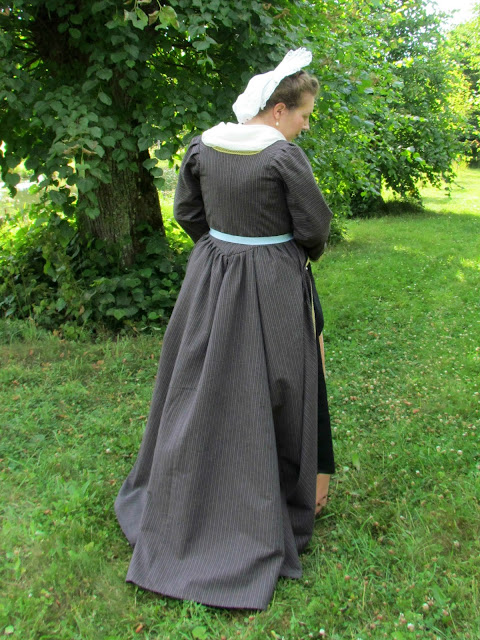What the item is: A stole, or mantilla.
There are two extant examples of this kind of garment in Scandinavia One in Denmark and one in Sweden. Both are made of black silk gauze and embroidered white silk. It’s a shawl, there the front is elongated with an extra panel. From the front this makes it look like a gown when worn. Both the extant mantillas have a stomacher made of the white fabric. The Swedish one is dated to the 1690’s, the Danish one to 1695-1709(ish)
 |
| Nationalmuseum, Denmark |
 |
| Nordiska museet, Sweden |
I’ve found very little information about this kind of garment. Ellen Andersen writes that this type of garment originated from Spain, and has been known since the late 16th century. In France it became popular in the 1720’s. Garsault mentions it in 1769, when he talks about how a lady should dress for court presentation:
If the Lady to be presented is not able to endure the heavily boned bodice [of a robe de cour] then she is allowed to wear a lighter one, covered with a mantilla, with the court train and petticoat. As the mantilla covers the upper arm the top lace flounce, which would not be seen, is omitted. The mantilla is made from any light material such as gauze, net, lace, etc.
I strongly suspect the boundaries between the kind of mantilla I have made, and one which is just a plain shawl, is very hazy. I have only found one painting where I’m almost sure the lady is wearing a mantilla. Christina Brodersonia, Carl Linneaus mother:
It drapes the right way, but it may, of course, only be a shawl. There is certainly not difficult to find paintings of 18th century women wearing shawls. Most of them only show the upper half of the body.
It seems to me that this must be a versatile garment. It’s a lightweight wrap and worn over just stays and petticoats it must have been a good alternative for a hot day. It must also have been quite practical to wear during pregnancies.
The Challenge: Monochrome
Fabric: White silk brocade. Black silk habotai.
Pattern: I used the pattern in Danske Dragter , though adapting it to fit my own body. I aimed to keep the ratio between measurements the same as in the original pattern. In retrospect I could have cut the black silk shorter, but it still works. I omitted the stomacher as I realised I had enough brocade left to make a pair of stays, if I did so.
Year: 1695-1709, but can probably be stretched a bit further into the 18th century.
Notions: Silver lace and white sewing silk. I cut the lace down the middle to make it go further. Silk ribbons to bind the seams in.
How historically accurate is it? The pattern is made after an original garment. However, the original was made of white embroidered silk and black silk gauze. So I would say about 80%.
Hours to complete: I cut it all out just before Midsummer. It’s completely hand sewn and I have been sewing all summer, but I have no idea how many hours it took.
First worn: For these photos. I apologize for wearing a pair of 1780’s stays. All my other stays are in the attic, and I was feeling lazy. Period accurate makeup; pearl powder, burnt clove for the eyebrows and lip pomade coloured with alkanet. Reproduction earrings from Dames a la Mode.
Total cost: 1045 Euro. One yard silk habotai: 13 Euro. Three yards of silk brocade: 60 Euro (but I will get a pair of stays out of it too). Fourteen yards of silver lace: 40 Euro. 18 yards of habotai silk ribbon: 32 Euro. Thread from my stash.
Sources: Andersen, Ellen, Danske Dragter: Moden i 1700-årene, Nationalmuseet, 1977
Brown, Carolina, Mode: klädedräktens historia genom fem sekler, Rabén & Sjögren, 1991
Waugh, Nora, The Cut of Women's Clothes, 1600-1930, Routledge, 1984






























































